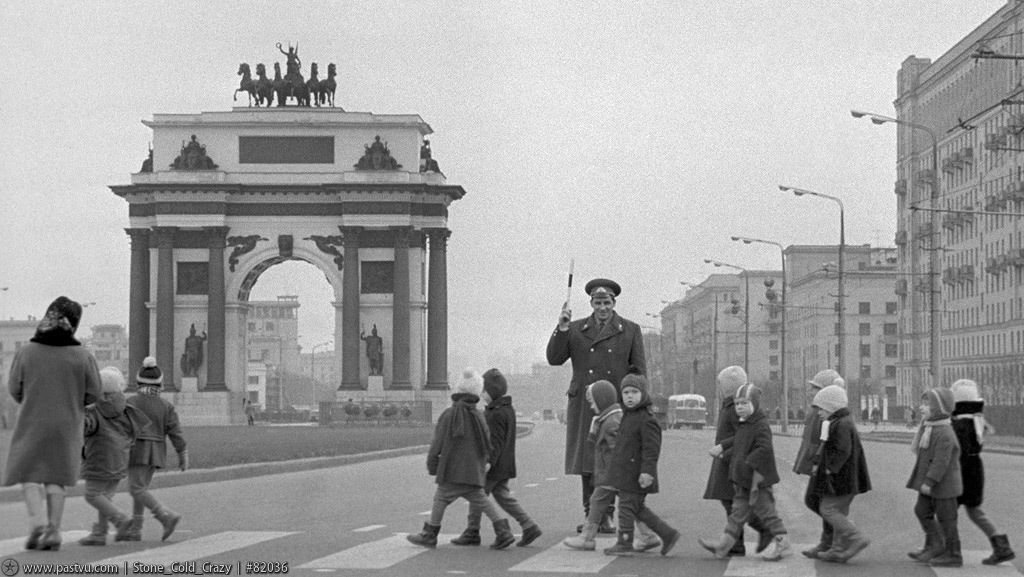История Триумфальной арки начинается с возведения летом 1814 года на площади Тверской заставы деревянной Триумфальной арки — она чествовала русскую армию, возвращавшуюся из Европы после разгрома Наполеона. Место выбрали неслучайно: обычно именно здесь, на въезде в город, московские градоначальники, дворяне и почётные граждане встречали императора, прибывающего из Северной столицы.
В 1826 году Николай I решил, что память о победе заслуживает чего-то более долговечного, и повелел заменить деревянные ворота каменными. Проект заказали знаменитому зодчему Осипу Бове. Возведение Триумфальной арки закончилось лишь в 1834 году, автор не дожил нескольких месяцев до этого момента, и завершал строительство его младший брат Михаил Бове.
Сооружение получилось по-настоящему величественным: шесть пар колонн обрамляли высокие постаменты с мощными фигурами античных воинов, символизирующих Победу, Славу и Храбрость. На фризе расположили гербы 36 российских губерний, чьи жители участвовали в Отечественной войне 1812 года, и медальоны с вензелем Николая I. Фронтон с обеих сторон украсила надпись, прославляющая Александра I как спасителя Отечества. Венчала арку колесница Славы, которой правила Ника — крылатая богиня победы.
Арка на Тверской заставе с течением времени прошла множественные реставрации, но в 1936 году была демонтирована в связи с реконструкцией площади. Большинство элементов почистили и обновили сотрудники музея архитектуры имени А.В. Щусева, а затем отправили на хранение в филиал музея на территории Донского монастыря, где они и пребывают поныне. Были проведены замеры сооружения, составлены подробные чертежи, сделаны фотографии.
В 1965 году Совет Министров СССР наконец признал большую художественную ценность и общественно-историческое значение Триумфальных ворот и приказал восстановить их. Но в ансамбль площади у Белорусского вокзала они уже не вписывались, и им нашли новое подходящее место — на Кутузовском проспекте. Проектом назначили руководить архитектора-реставратора В.Я.Либсон. Пользуясь чертежами и фотографиями 1936 года, а также авторской копией арки, которая хранилась в Музее архитектуры, коллектив архитекторов создал все элементы заново. Упоминание об Александре I убрали, зато процитировали строки из обращения Кутузова к армии. Церемония открытия памятника состоялась 6 ноября 1968 года.
Время не щадит ни камень, ни металл, и в начале XXI века специалисты отметили, что Триумфальным воротам нужна реставрация. Её провели в 2012 году, к 200-летию Отечественной войны 1812 года.

В 1893 году Савва Морозов, знаменитый купец и промышленник, решил купить старую усадьбу Аксаковых на Спиридоновке и построить для своей любимой жены Зинаиды особняк. Молодой архитектор Фёдор Шехтель создал здесь настоящий средневековый замок, сделавший его знаменитым и модным архитектором, к которому выстроилась очередь из богатых заказчиков.
Технологии дополненной реальности в приложении «Узнай Москву» позволят вам узнать историю создания особняка непосредственно от цифрового двойника Саввы Тимофеевича Морозова. Вам надо всего лишь открыть карточку объекта в приложении, нажать кнопку “Дополненная реальность” и погрузиться в изучение истории знаменитого особняка.













%20BEL_0521.jpg&w=1920&q=75)





